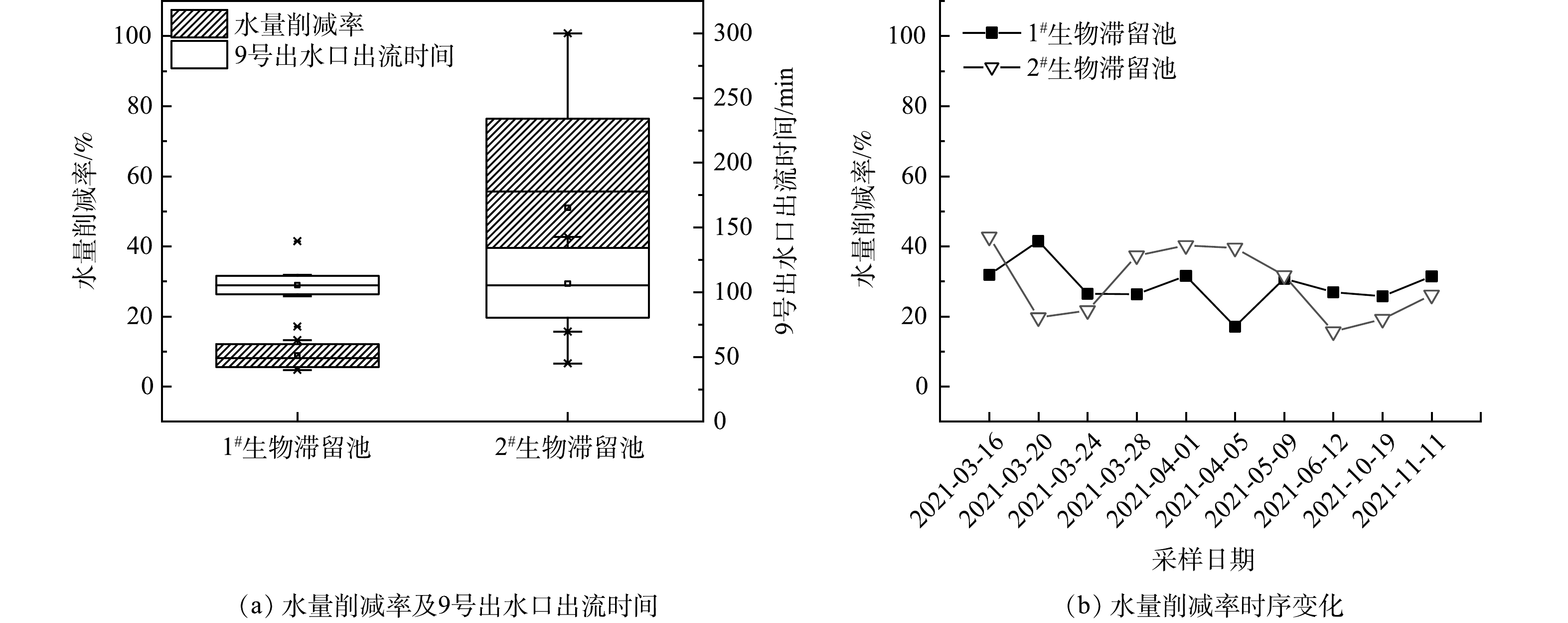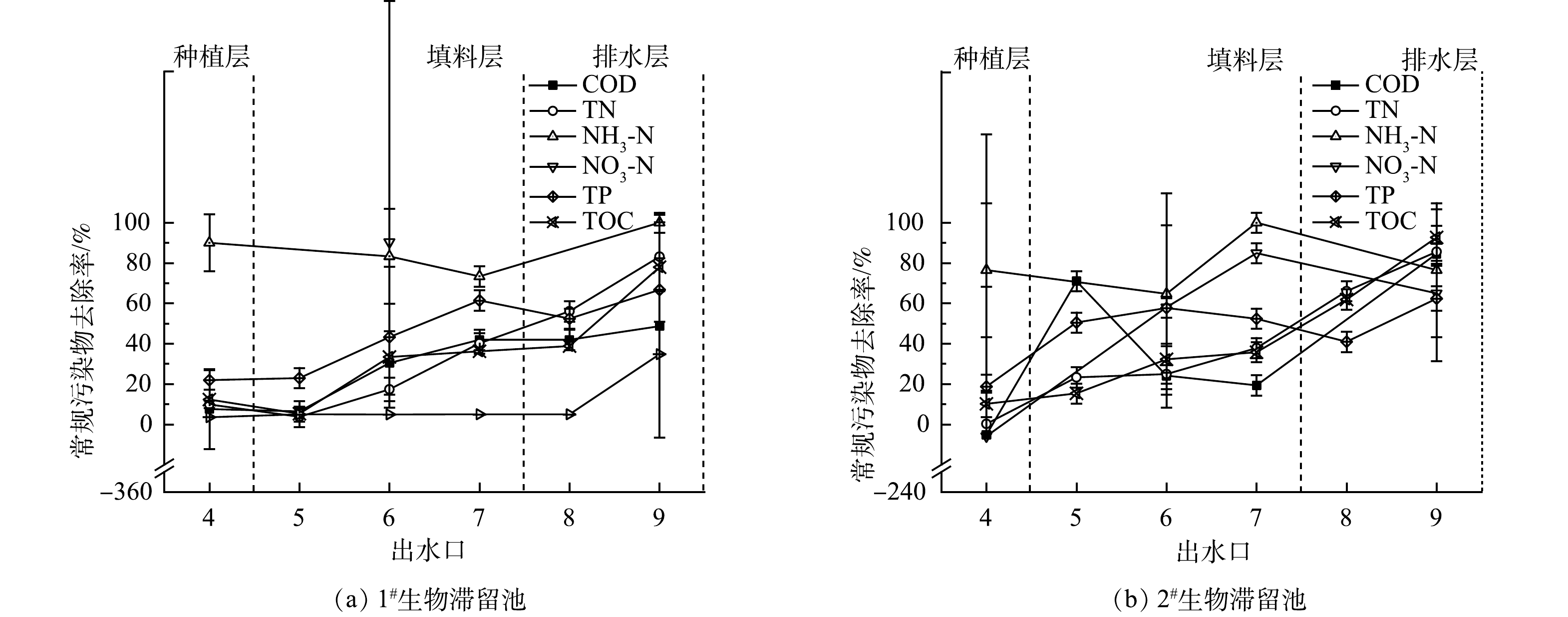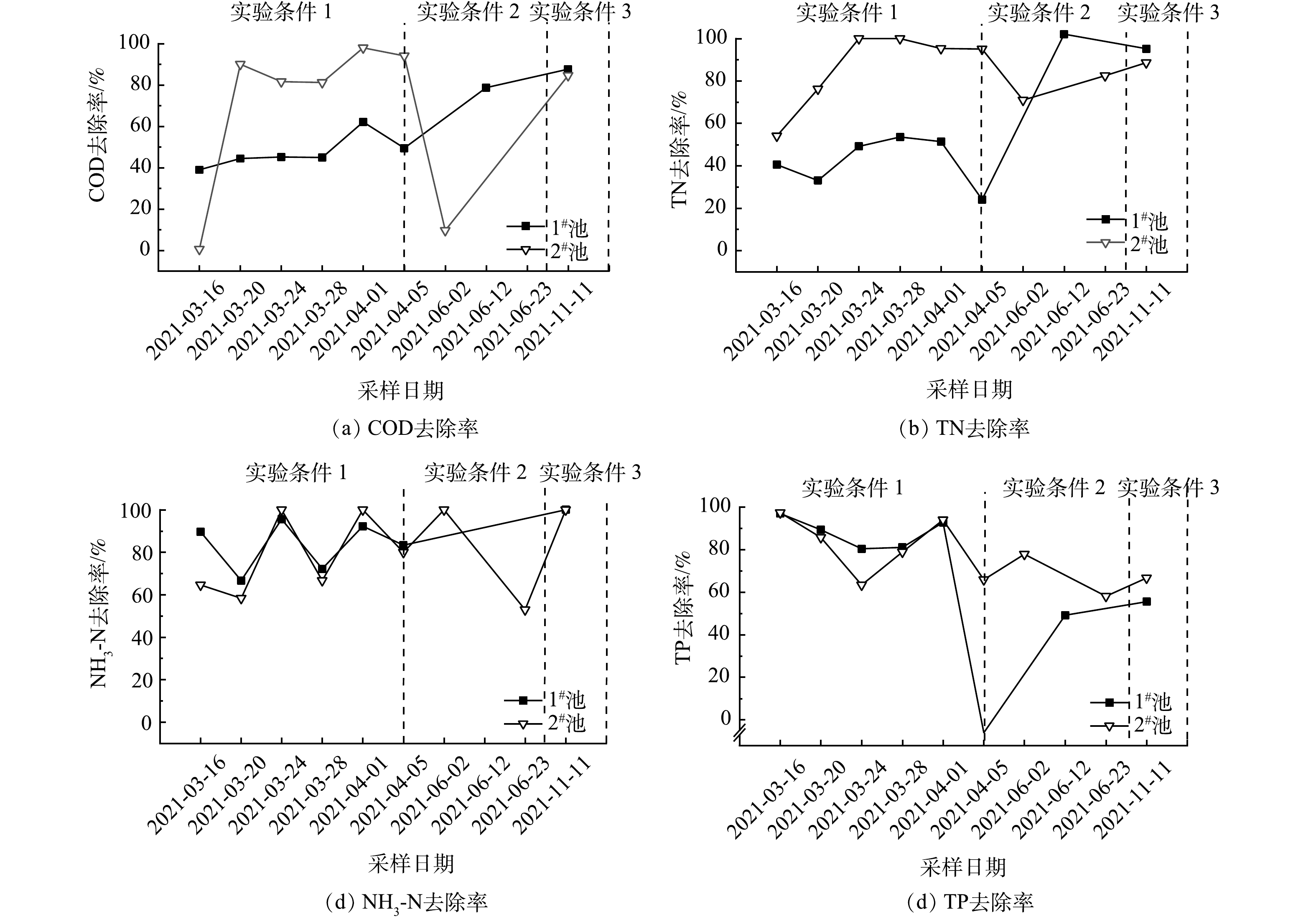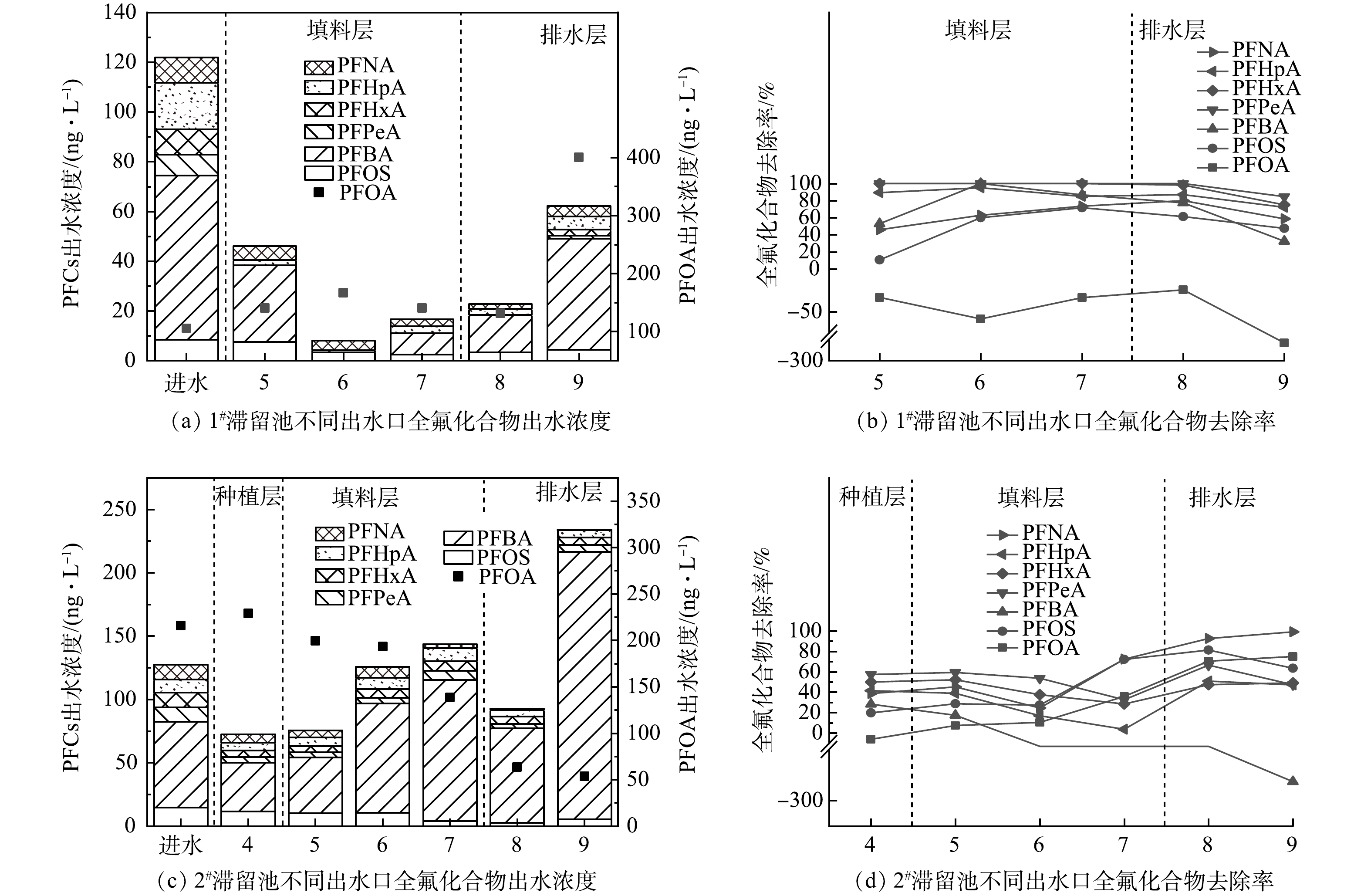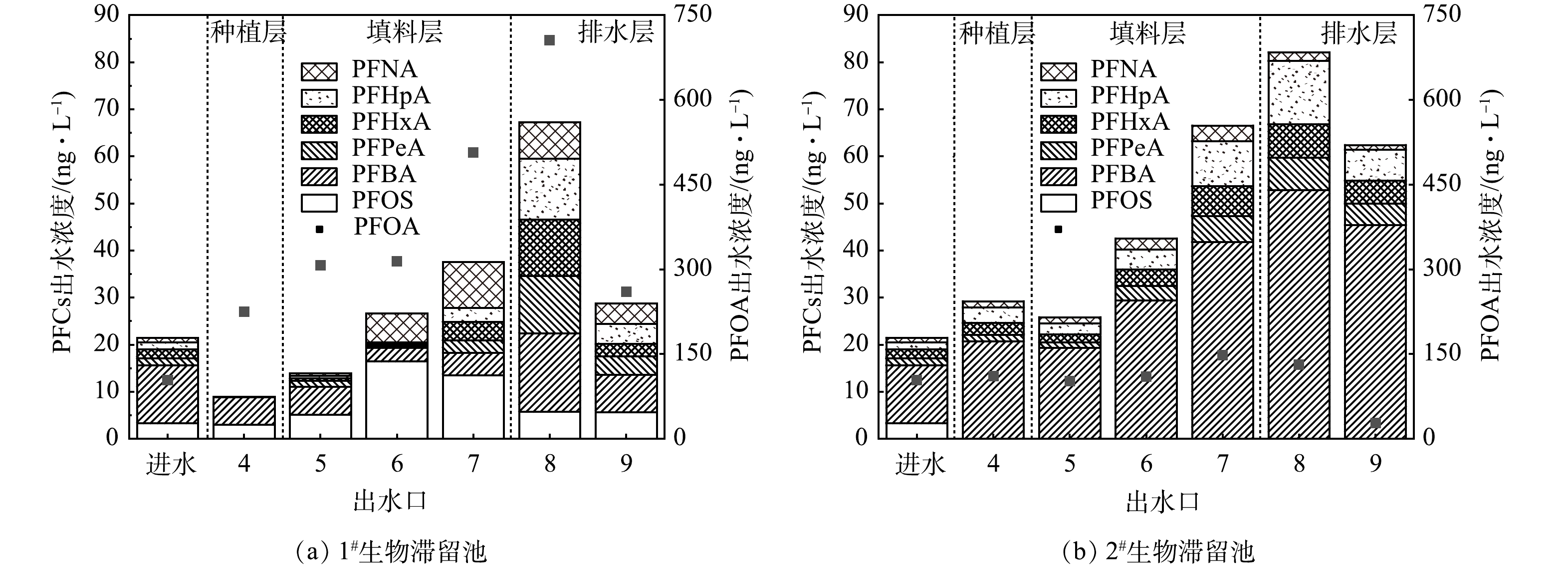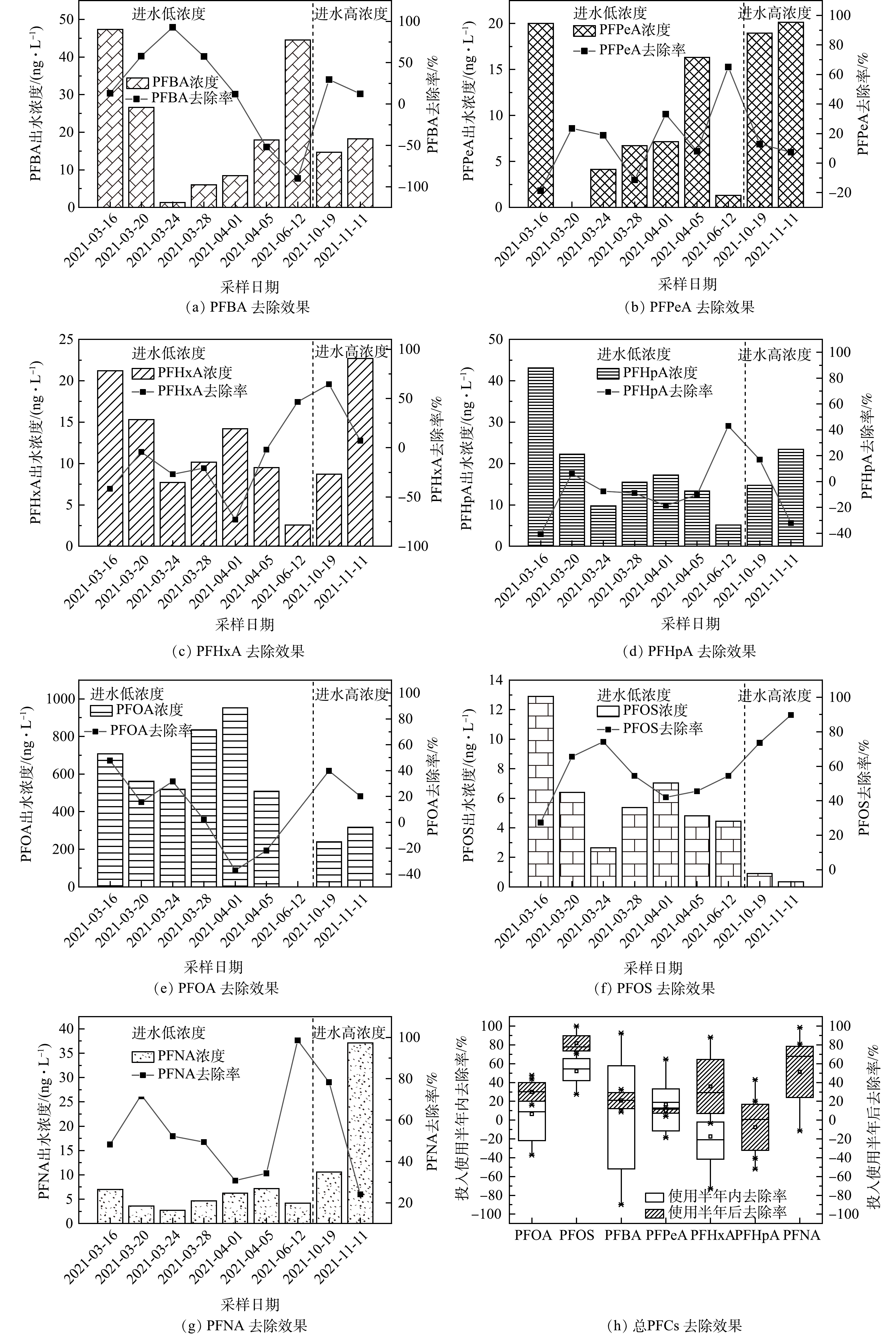-
近年来随着我国城镇化水平的深入推进,城市下垫面不透水层比率迅速提高,加速了径流形成过程,缩短了径流汇集时间;与此同时,人类活动增加了蓄积在城市下垫面污染物的种类和数量。二者共同作用,使得由地表径流引发的城市水体污染问题日益突出[1]。生物滞留池是用于城市雨洪管理的一种低影响开发(low impact development, LID)技术,其可通过地表径流原位滞留调节峰值流量,并通过吸附、生物吸收和降解以去除地表径流中的污染物[2]。有研究表明,生物滞留池对传统目标污染物,如重金属[3]、多环芳烃[4]、总氮、总磷等均具有较好的去除效果[5-6]。
全氟化合物(perfluorinated compounds, PFCs)是一种典型的新污染物,作为表面活性剂和保护剂被广泛应用于日常用品及工业生产中。PFCs具有生物毒性和生物累积性,可在人体内蓄积造成健康危害[7]。城市下垫面累积的全氟和多氟烷基化合物(per/polyfluoroalkyl substances, PFASs)主要来源于大气PFASs及其前体物的传输和沉降[8-9],并在雨水冲刷下进入受纳水体。有研究表明,雨季河水中的PFASs浓度水平明显高于旱季[10]。因此,地表径流中的PFCs含量不可忽视,明确生物滞留池对PFCs的削减效能对城市面源污染防治和可持续发展具有十分重要的现实意义和科学价值。
传统生物滞留系统的填料层(bioretention soil media,BSM)常由土壤与细砂混合而成,具有良好的渗透性能[11]。近年来,以煤质活性炭、沸石等为主要改良剂的生物滞留池得到了广泛运用。活性炭层可明显提高脱氮效率,使氨氮(NH3-N)和总氮(TN)的平均去除率达到80.27%和59.45%[12],沸石层对多环芳烃的去除率达40%以上[13]。然而,改良填料层对PFCs的去除能力及各污染物在系统中的空间分布特征尚不清楚。为此,本研究通过构建不同填料的生物滞留系统,利用为期1 a的模拟实验考察了改良填料下生物滞留池的水量削减效能,分析了其对常规污染物和PFCs的去除效果,探讨了PFCs是否影响常规污染物去除及其长期运行能力,以期为城市雨洪综合管理提供参考。
-
生物滞留装置采用有机玻璃PMMA材料制成,高度1 500 mm,直径400 mm。距池顶150 mm处设溢流口,沿柱体向下每间隔150 mm设置取样口,共8个取样口,取样口均封有纱网布。设备底部预留滞留体积,接直径为25 mm出水管(图1)。滞留装置基质层填料类别不宜过多,BSM由河沙、土、树皮按质量比65:30:5比例构成[14]。JIANG等[15]设置BSM+10%绿色沸石、BSM+10%粉煤灰等6种改良生物滞留系统,其对溶解性污染物较好均有较好的去除效果。因此,本研究中1#生物滞留池填料层由BSM+10% 2~4 mm沸石(BSM+10% Zeolite)组成;2#池填料层由BSM+10% 2~4 mm煤质颗粒活性炭(BSM+10% GAC)组成。滞留装置由下至上分别是150 mm砾石排水层(粒径24 mm)、600 mm填料层和300 mm的种植层。种植层填料为场地附近红土,种有生性强健、耐阴耐湿的紫芋。种植层表面为50 mm高的覆盖层,材料为树皮。各层间由土工布隔开并预留出200 mm高蓄水层。锡纸包裹柱体种植层以下外壁,模拟无光环境,为厌氧菌提供生存条件。为防止短流,1#生物滞留池内侧用云石胶贴有砾石。
-
根据ZENG等[16]的研究,采用NH4Cl、KNO3、KH2PO4、尿素、葡萄糖、7种PFCs配置人工雨水。PFCs包括全氟辛酸(perfluorooctanoic acid,PFOA)、全氟丁酸(perfluorobutanoic acid,PFBA)、全氟辛基磺酸(perfluorooctane acid,PFOS)、全氟戊酸(perfluoropentanoic acid,PFPeA)、全氟己酸(perfluorohexanoic acid,PFHxA)、全氟庚酸(perfluoroheptanoic acid,PFHpA)和全氟壬酸(perfluorononanoic acid,PFNA)。污染物分别为1.5 mg·L−1
$ {\mathrm{N}\mathrm{H}}_{4}^{+} $ -N、 4 mg·L−1$ {\mathrm{N}\mathrm{O}}_{3}^{-} $ -N、1.2 mg·L−1 TP、10 mg·L−1 TN、300 mg·L−1 COD;30 ng·L−1 PFOA、10 ng·L−1 PFBA、10 ng·L−1 PFOS、10 ng·L−1 PFPeA、10 ng·L−1 PFHxA、10 ng·L−1 PFHpA、10 ng·L−1 PFNA。将上述各PFCs浓度定为c,每个生物滞留池按表1所示实验条件分别进行3组实验。 -
硝酸钾和硫酸(AR,纯度>95%)购自广州化学试剂公司;无水硫代硫酸钠(纯度>99%)购自上海阿拉丁生化科技股份有限公司;葡萄糖购自上海润捷化学试剂有限公司;氯化铵购自CNW公司(德国);磷酸二氢钾购自天津市科密欧化学试剂有限公司;OasisWAXSPE柱(6cc,150mg)购自Waters公司(美国)。
采用HACH DRB200消解器和DR3900分光光度计,根据《水和废水监测分析方法 (第四版) 》中的国家标准或行业标准分析方法测定:COD采用快速消解法、TN采用碱性过硫酸钾消解紫外分光光度法、TP采用钼锑抗分光光度法、
$ {\mathrm{N}\mathrm{H}}_{4}^{+} $ -N采用水杨酸法、$ {{\rm{NO}}}_{3}^{-} $ -N采用镉还原法。利用岛津TOC-L总有机碳分析仪测定TOC。采用WatersXevoTQ-S质谱仪,根据液相色谱-串联质谱法测定7种PFCs。上机前PFCs需采用固相萃取法对样品进行前处理:采集的水样经玻璃纤维滤膜(WhatmanGF/F,英国)过滤,加入50μL 0.1 mg·L−1 碳代全氟壬酸(MPFNA)内标与50 μL0.1 mg·L−1 5种混合内标。Oasis-WAX小柱由4 mL 0.1%氨水-甲醇溶液、4 mL甲醇溶液和4mL超纯水活化,水样经60 mL注射器,以约1滴·s−1的速度匀速通过Oasis-WAX小柱。上样结束后,加入4 mL乙酸铵缓冲液于注射器中进行清洗。清洗结束后,加压抽干,依次加入4 mL甲醇和4 mL 0.1%氨水-甲醇溶液洗脱,收集洗脱液至氮吹仪吹干,加入0.5 mL甲醇溶液定容并涡旋30 s,通过0.22 μm滤膜贮存至聚丙烯进样瓶中,-20 ℃保存等待上机检测。 -
利用Masslynx软件对PFCs数据进行处理。水量削减效果使用水量削减率
$ {R}_{\mathrm{V}} $ 进行评价,根据式(1)进行计算,水质净化效果使用污染物浓度去除率$ {R}_{\mathrm{c}} $ 评价,根据式(2)进行计算。式中:
$ {R}_{\mathrm{V}} $ 为径流体积削减率,%;$ {R}_{\mathrm{c}} $ 为污染物浓度去除率,%;$ {V}_{\mathrm{i}\mathrm{n}}\mathrm{、}{V}_{\mathrm{o}\mathrm{u}\mathrm{t}}\mathrm{、}{V}_{\mathrm{o}\mathrm{v}\mathrm{e}\mathrm{r}} $ 分别为进水、出水、溢流水量,m3;$ {C}_{\mathrm{i}\mathrm{n}}\mathrm{、}{C}_{\mathrm{o}\mathrm{u}\mathrm{t}} $ 分别为降雨径流进水和出水的浓度,mg·L−1。 -
生物滞留装置底部出水口出流时间和水量削减率如图2(a)所示。1#生物滞留池首次出流时间稳定,平均值为(51±9) min。2#生物滞留池平均出流时间高于1#生物滞留池且不稳定,平均值为(165±90) min;其运行初期出流时间高于后期,尤其在投入使用0.5 a后底部出流明显加快。这说明2#生物滞留池填料透水率随运行时间增加而增高,提示长期运行时需考虑煤质活性炭在雨水浸泡后的老化情况和使用年限。1#生物滞留池水量削减率为17.13%~41.48%,2#生物滞留池为15.67%~42.7%,两池的水量削减率相当。匡彬等[17]的研究表明,在P=1、2 a 等小重现期降雨条件下,绿色雨水系统对径流量和峰流量的削减效果较好。当降雨强度为1 a一遇时,径流总量削减率达到21.7%。本研究中重现期设定为0.5 a, 1#和2#生物滞留池水量削减率平均值分别为30.3%和29.4%,削减率与文献报道结果一致[18]。图2(b)为生物滞留池水量削减率随运行时间的变化情况。如图2所示,削减率随运行时间增长呈现波动下降的趋势,其中,2#生物滞留池削减率后期下降趋势更为明显。
-
1)常规污染物在生物滞留池中纵向迁移情况。为考查污染物在滞留池中的纵向迁移规律,获取连续3次降雨间隔为10 d的各出水口常规污染物去除率。如图3(a)~(b)所示,目标污染物的去除率随池深增加而提高,说明填料层对常规污染物去除起到关键作用。其中活性炭的比表面积、微孔体积大,有利于为基质提供更多的吸附位点;沸石表面呈粗糙多孔结构,这有利于对离子的物理吸附[19]。
1#生物滞留池由上至下对COD、TP、TOC的去除率均逐渐上升。9号出水口COD、TP、TOC的去除率为48.68%、66.71%、 77.96%。1#生物滞留池对
$ {\mathrm{N}\mathrm{H}}_{4}^{+} $ -N的去除率较高,保持在80%以上;但对$ {\mathrm{N}\mathrm{O}}_{3}^{-} $ -N的去除率波动大,去除率多为负值,最低可达-150%。2#生物滞留池COD、TP和TOC的去除率随柱深增加而增加。9号出水口COD、TP、TOC的去除率84.62%、62.38%、 92.69%。与1#生物滞留池相近,2#生物滞留池$ {\mathrm{N}\mathrm{H}}_{4}^{+} $ -N去除率在60%以上,呈W型,$ {\mathrm{N}\mathrm{O}}_{3}^{-} $ -N去除率波动大且效能低。这主要是因为$ {\mathrm{N}\mathrm{O}}_{3}^{-} $ -N带负电,难以吸附到填料上,加之生物滞留系统不易形成厌氧环境致使反硝化反应难以进行[20]。综上所述,两池均能有效去除COD、TOC、TP,且去除效能2#生物滞留池优于1#生物滞留池。尽管$ {\mathrm{N}\mathrm{H}}_{4}^{+} $ -N去除率较高,但$ {\mathrm{N}\mathrm{O}}_{3}^{-} $ -N难以被生物滞留池去除,最终导致TN去除效果不佳。2)生物滞留池对常规污染物去除效果的长期稳定性情况。为考察生物滞留池对常规污染物的长期去除性能,系统在8个月内以不同实验条件进行了非连续地降雨实验,其中实验条件1在3—4月,条件2在5—8月,条件3在9—11月下进行。如图4(a)所示,1#生物滞留池COD去除率呈稳定并略有上升的趋势。由38.97%(3月)增长至87.69%(11月);2#生物滞留池COD去除率较1#生物滞留池波动明显,但除去2次异常低值后,COD去除率达80%以上。2#生物滞留池的2次异常低值,分别出现在第1次实验和与前次实验间隔期间较长的第7次实验,考虑为COD浸出与气候的影响。由图4(b)可见,2组生物滞留池对TN的去除效果有着不同的趋势。1#生物滞留池波动较大,去除率偏低,TN去除率由40.52%增至运行后期的95.28%。2#生物滞留池恰好相反,前期TN去除率较高,后期降低。由图4(c)可见,2组生物滞留池对
$ {\mathrm{N}\mathrm{H}}_{4}^{+} $ -N的去除率出现波动,$ {\mathrm{N}\mathrm{H}}_{4}^{+} $ -N去除率最高为 100%,最低分别为66.67%和52.94%。该波动下降可能是因降雨实验间隔时间过长导致的。冉阳等[20]研究证明,干旱期的延长有利于去除硝酸盐氮,但对氨氮的去除有阻碍作用。在6种目标常规污染物中,2组生物滞留池对$ {\mathrm{N}\mathrm{O}}_{3}^{-} $ -N的去除效果均不理想,且装置长期运行也未能提高$ {\mathrm{N}\mathrm{O}}_{3}^{-} $ -N去除率。造成生物滞留系统$ {\mathrm{N}\mathrm{O}}_{3}^{-} $ -N 去除率波动的原因可能是介质中缺少反硝化细菌生存所需要的缺氧条件,NH3-N 被消耗,而产生大量 NO3—-N,导致其去除效果不佳。由图4(d)可见,TP去除率呈小幅波动下降趋势。在雨水径流中磷的存在形态主要是颗粒态磷,主要通过填料过滤截留去除。因此,填料有效吸附位点数随运行时间增加而逐渐减少[21],最终导致TP去除率下降。综上所述,系统对COD去除效能稳定,对TP的去除效能随运行时间增长而下降,$ {\mathrm{N}\mathrm{H}}_{4}^{+} $ -N去除率与降雨时间间隔有关。 -
1)全氟化合物在生物滞留池中迁移规律。通过分析各出水口PFCs总量可知,1#生物滞留池在6号出水口获得最高去除率(实验条件2),池底出水口PFCs去除率反而明显下降(图5(a)~(b)),其中对PFOA的去除率尤为低下(-279%)。同样地,2#生物滞留池8号出水口达到最高,底部9号出水口PFPeA、PFHxA、PFHpA、PFOS去除率下降,PFBA下降幅度最为明显(图5(c)~(d))。因此,2组生物滞留池对PFCs的去除沿柱深方向呈现先增加后降低的趋势,说明填料层对PFCs结合不稳定,加之生物滞留池排水快速,短时间内微生物降解难以发挥作用。连续降雨情况下,PFCs可能在生物滞留池发生浸出,导致PFCs出水浓度高于进水浓度。就具体物质而言,PFHxA、PFPeA、PFBA、PFHpA去除率接近100%,而PFBA和PFOS的去除率较低(60%),但该差异原因尚不清楚。
2)全氟化合物在生物滞留池中的浸出情况。生物滞留池在运行近3个月后,为进一步分析PFCs在生物滞留池中的浸出情况,采用加入硫代硫酸钠除氯后的自来水作为进水,测定滞留池各出水口PFCs浓度。由图6(a)可见,1#生物滞留池4号出水口PFOS有明显降低,说明种植层土壤仍对PFCs有截留作用;5~8号出水口PFCs出水浓度呈升高趋势,甚至出现了进水含量较低的PFNA、PFHpA;7号出水口PFHpA的浸出尤为明显;PFOA在8号出水口的出水质量浓度达到705.25 ng·L−1。上述结果证实了PFCs截留在5~8号出水口的填料层,但并未被转化降解。由图6(b)可见,2#生物滞留池中同样存在PFCs浸出情况,但PFOA的浸出量较1#生物滞留池(147.70 ng·L−1)大幅减少,说明煤质活性炭中PFCs不易脱出,运行稳定性更有保障。
3)生物滞留池对全氟化合物去除效果的长期稳定性情况。通过分析2021年3—11月生物滞留池底部出水口PFCs去除率,判断其长期使用潜能。如图7所示,由1#生物滞留池对PFCs去除效能随降雨次数的增加而降低。具体来说,3—4月间PFBA、PFHxA、PFOA和PFOS去除率逐次降低,甚至出现负值即存在浸出现象。但值得注意的是,上述物质去除效能在间隔2个月后得到恢复,推断长时间干旱条件下,PFCs在池内出现了降解转化,释放了填料层的吸附容量,后续需结合微生物实验验证。
如图8所示,2#生物滞留池对PFCs去除效果远优于1#生物滞留池,说明其具有长期使用的潜能。PFHxA、PFHpA、PFNA、PFOS的去除较稳定(>60%),其中PFOA去除率高于 85%,这个结果印证了煤质活性炭具有高效地吸附去除PFOA的能力[22],PFPeA去除率有一定波动,均值为62.12%。
-
1) 1#生物滞留池对径流水量的平均削减率为(30.3±6.2)%,2#生物滞留池对径流水量的平均削减率为(29.3±10.1)%。随着投入使用时间的延长,2组生物滞留池的水量削减率均呈现波动下降的趋势,其中2#生物滞留池的下降趋势明显。
2) 2组生物滞留池对常规污染物均有较好的去除效果。其中,2#生物滞留池对COD、TP、TOC、TN 的去除率分别为84.6%、62.4%、92.7%、85.6%。生物滞留池对常规污染物的去除主要依靠填料层的吸附作用,但种植层中植物根系与土壤也具备一定的净化能力。在经过将近1 a后,2#生物滞留池对常规污染物仍保持较好的去除效果。
3) PFCs在生物滞留池中浓度分布规律明显。PFBA主要集中于种植层,而PFPeA、PFHxA、PFHpA、PFOA、PFOS、PFNA则更集中于填料层,1#生物滞留池对PFCs的去除效果在0.5 a后由明显下降,而2#生物滞留池对多数PFCs的去除效率还保持在较高的水平,说明其具有长期使用的潜能。
生物滞留池对地表径流中常规污染物及全氟化合物的去除效果
Removal of conventional pollutants and perfluorinated compounds from urban storm water by bioretention system
-
摘要: 生物滞留系统是实现城市地表径流水量调控和水质净化的新型绿色生态系统,但其对全氟化合物的去除效能尚不清楚。本文构建了将传统填料与2~4 mm沸石(体积占比10%)或2~4 mm的改良煤质颗粒活性炭(体积占比10%)混合的2种柱形生物滞留系统,通过动态实验探究了此系统对地表径流中常规污染物和全氟化合物去除效果,分析了系统近1 a的运行效果。结果表明,生物滞留系统的水量削减率随运行时间的增长呈现下降的趋势,平均削减率为(29.8±8.2)%。改良煤质颗粒活性炭生物滞留池对COD、TN、TP、TOC、
$ {\mathrm{N}\mathrm{H}}_{4}^{+} $ -N的平均去除率分别为67.49%、84.78%、76.43%、80.28%、65.43%,优于以沸石为填料的滞留池。6种目标全氟化合物PFPeA、PFHxA、PFHpA、PFOA、PFOS、PFNA的去除率保持在80%以上。滞留池内污染物空间分布特征表明,PFBA主要集中于种植层,而PFPeA、PFHxA、PFHpA、PFOA、PFOS、PFNA则更集中于填料层。Abstract: Bioretention system is a new and green ecosystem to regulate the urban surface runoff and water quality purification, but its removal efficiency for perfluorinated compounds is unknown. Based on the reported concentrations of perfluorinated compounds in surface runoff, two cylindrical bioretention systems were constructed with traditional fillers mixed with 2~4 mm zeolite (volume ratio of 10%) or 2~4 mm improved coal granular activated carbon (volume ratio of 10%) as the main fillers. The removal efficiencies of conventional contaminants and perfluorinated compounds by both systems were investigated, as well as the one-year operation efficiency. The results showed that the water reduction rate decreased with the extension of operation time, and the average reduction rate was (29.8±8.2)%. After one-year operation, the average removal rates of COD, TN, TP, TOC and$ {NH}_{4}^{+} $ -N by the bioretention column with the improved coal granular activated carbon were 67.49%, 84.78%, 76.43%, 80.28% and 65.43%, respectively, which were better than bioretention column with zeolite. The removal efficiencies of PFPeA, PFHxA, PFHpA, PFOA, PFOS and PFNA maintained above 80%. The spatial distribution of pollutants showed that PFBA was mainly concentrated in the plant layer, while PFPeA, PFHxA, PFHpA, PFOA, PFOS and PFNA were concentrated in the filler layer.-
Key words:
- bioretention /
- perfluorinated compounds /
- surface runoff /
- reduction efficiency
-

-
表 1 生物滞留装置实验条件设计
Table 1. Experimental condition design (for a single bioretention column)
实验条件 进水浓度 重现期/a 降雨历时/min 实验水量/L 降雨间隔/d 1 c 0.5 180 58 3 2 c 0.5 180 58 10 3 2c 0.5 180 58 20 -
[1] 马学琳, 李洪波, 罗宁, 等. 城市地表径流污染研究[J]. 中国资源综合利用, 2021, 39(5): 112-114. doi: 10.3969/j.issn.1008-9500.2021.05.034 [2] 周媛, 张立秋, 杨龙, 等. 生物滞留设施运行常见问题及调控措施研究进展[J]. 净水技术, 2022, 41(9): 26-34. doi: 10.15890/j.cnki.jsjs.2022.09.004 [3] LIU C, LU J, LIU J, et al. Effects of lead (Pb) in stormwater runoff on the microbial characteristics and organics removal in bioretention systems[J]. Chemosphere, 2020, 253: 126721. doi: 10.1016/j.chemosphere.2020.126721 [4] 顾莉, 张苏艳, 华祖林, 等. 生物滞留池中多环芳烃去除研究进展[J]. 河海大学学报(自然科学版), 2018, 46(2): 106-114. [5] 王亚军, 耿冲冲, 许妍, 等. 不同强化手段对生物滞留池脱氮除磷性能的影响[J]. 中国给水排水, 2020, 36(19): 77-82. doi: 10.19853/j.zgjsps.1000-4602.2020.19.013 [6] OKAIKUE-WOODI, F E K, CHERUKUMILLI K, et al. A critical review of contaminant removal by conventional and emerging media for urban stormwater treatment in the United States[J]. Water Research, 2020, 187: 116434. doi: 10.1016/j.watres.2020.116434 [7] 朱永乐, 汤家喜, 李梦雪, 等. 全氟化合物污染现状及与有机污染物联合毒性研究进展[J]. 生态毒理学报, 2021, 16(2): 86-99. [8] 姚义鸣, 赵洋洋, 孙红文. 天津市大气中全氟化合物挥发性前体物的分布和季节变化[J]. 环境化学, 2016, 35(7): 1329-1336. doi: 10.7524/j.issn.0254-6108.2016.07.2015120903 [9] 郑宇, 路国慧, 邵鹏威, 等. 青藏高原东部过渡区水环境中全氟化合物的分布特征[J]. 环境化学, 2020, 39(5): 1192-1201. doi: 10.7524/j.issn.0254-6108.2019081506 [10] WU J, JUNAID M, WANG Z F, et al. Spatiotemporal distribution, sources and ecological risks of perfluorinated compounds (PFCs) in the Guanlan River from the rapidly urbanizing areas of Shenzhen, China[J]. Chemosphere, 2020, 245: 125637. doi: 10.1016/j.chemosphere.2019.125637 [11] VILLAGRA-MENDOZA K, HORN R. Effect of biochar addition on hydraulic functions of two textural soils[J]. Geoderma, 2018, 326: 88-95. doi: 10.1016/j.geoderma.2018.03.021 [12] CHENG J, BI J, GONG Y, et al. Processes of nitrogen removal from rainwater runoff in bioretention filters modified with ceramsite and activated carbon[J]. Environmental Technology, 2022: 1-14. [13] 王建龙, 夏旭, 冯伟. 不同类型生物滞留介质对雨水径流中多环芳烃的去除效果[J]. 环境化学, 2020, 39(3): 670-676. doi: 10.7524/j.issn.0254-6108.2019102501 [14] 李家科, 张兆鑫, 蒋春博, 等. 海绵城市生物滞留设施关键技术研究进展[J]. 水资源保护, 2020, 36(1): 1-8. doi: 10.3880/j.issn.1004-6933.2020.01.001 [15] JIANG C, LI J, LI H, et al. Remediation and accumulation characteristics of dissolved pollutants for stormwater in improved bioretention basins[J]. Science of the Total Environment, 2019, 685: 763-771. doi: 10.1016/j.scitotenv.2019.06.246 [16] ZENG J, HUANG G, LUO H, et al. First flush of non-point source pollution and hydrological effects of LID in a Guangzhou community[J]. Scientific Reports, 2019, 9(1): 13865. doi: 10.1038/s41598-019-50467-8 [17] 匡彬, 欧阳二明, 汪涛. 基于LID的小区绿色雨水系统径流量控制研究[J]. 中国给水排水, 2015, 31(23): 134-138. doi: 10.19853/j.zgjsps.1000-4602.2015.23.034 [18] 欧阳友, 潘兴瑶, 杨默远, 等. 生物滞留设施水文要素精细化监测与水量平衡分析[J/OL]. [2021-11-03]. http://kns.cnki.net/kcms/detail/12.1073.TU.20211103.1017.002.html [19] 肖其亮, 熊丽萍, 彭华, 等. 人工湿地不同基质组合对污水中氮和磷吸附能力比选研究[J]. 环境科学研究, 2021: 1-17. [20] 冉阳, 付峥嵘, 唐宁远, 等. 改良生物滞留系统强化对雨水径流中氮磷的去除[J]. 环境科学与技术, 2021, 44(9): 49-57. doi: 10.19672/j.cnki.1003-6504.1128.21.338 [21] 张小玲, 朱光灿. 加气混凝土砌块吸附初期径流中磷的效果与机制[J]. 环境工程学报, 2018, 12(8): 2202-2209. doi: 10.12030/j.cjee.201801134 [22] SUN Y W, ANGELOTTI B, BROOKS M, et al. A pilot-scale investigation of disinfection by-product precursors and trace organic removal mechanisms in ozone-biologically activated carbon treatment for potable reuse[J]. Chemosphere, 2018, 210: 539-549. doi: 10.1016/j.chemosphere.2018.06.162 -






 下载:
下载:
